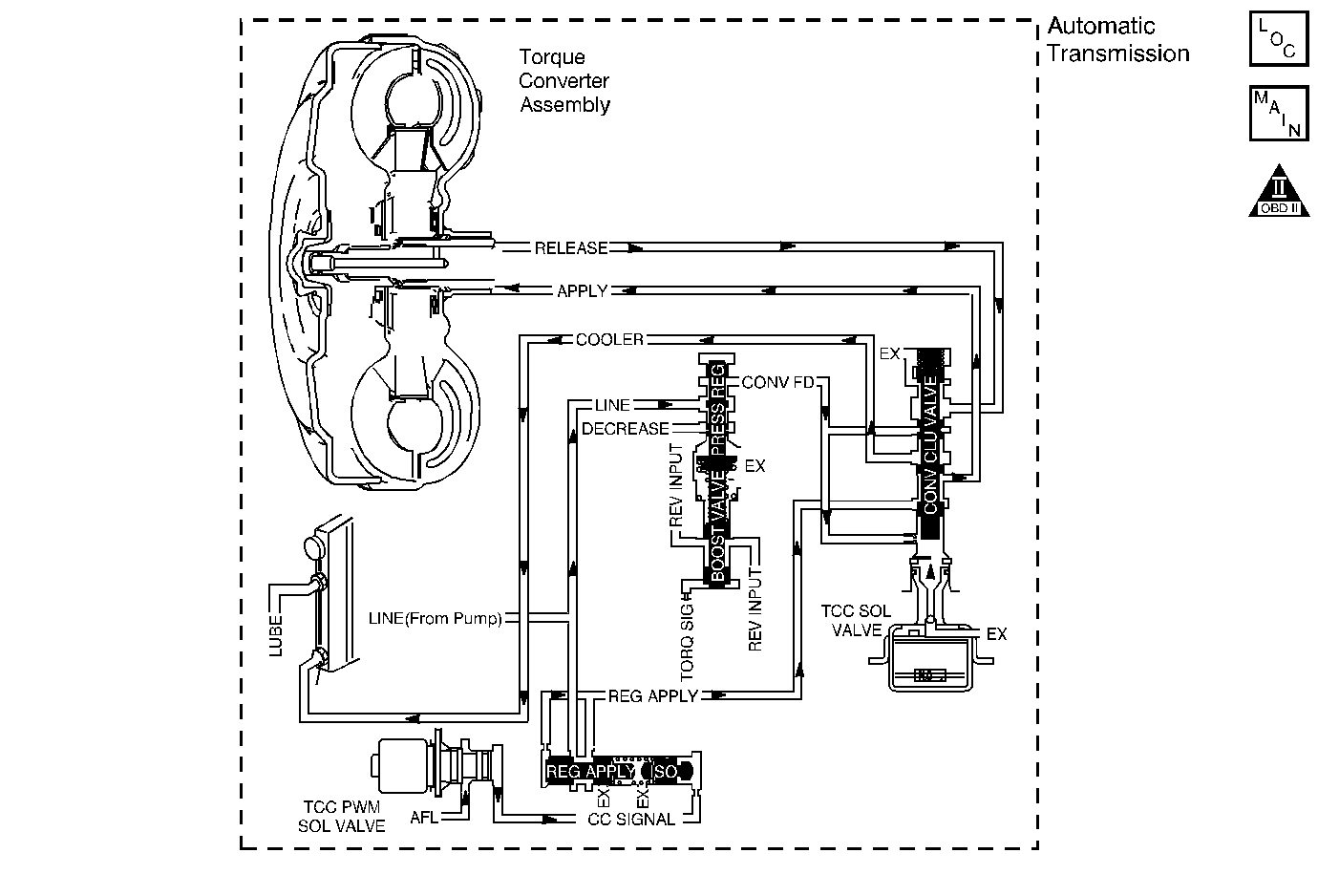| Table 1: | DTC P1870 Transmission Slipping Component |

Range | Gear | Shift Solenoid | TCC Solenoid | TCC PWM Solenoid | 2-4 Band | Forward Clutch | 2-4 Clutch | Torque Converter Clutch | |
|---|---|---|---|---|---|---|---|---|---|
1-2 | 2-3 | ||||||||
Overdrive | 4th | ON | OFF | ON | 90% (ON) | Applied | Applied | Applied | Applied |
Circuit Description
The VCM monitors the difference between engine speed and transmission output speed. In D3 drive range with the TCC engaged, the engine speed should closely match the transmission output speed. In D4 drive range, with the TCC engaged, the TCC slip speed should be -20 to +20 RPM.
When the VCM detects excessive TCC slip when the TCC should be engaged, then DTC P1870 sets. DTC P1870 is a type A DTC.
Conditions for Setting the DTC
The following conditions are met for three TCC cycles with reported excessive TCC slip conditions.
| • | No TP DTCs P0122 or P0123 |
| • | No VSS Assy. DTC P0502 |
| • | No TFT Sensor DTCs P0712 or P0713 |
| • | No 1-2 SS Valve DTCs P0751 or P0753 |
| • | No 2-3 SS Valve DTCs P0756 or P0758 |
| • | No TFP Val. Position Sw. DTC P1810 |
| • | No TCC PWM Sol. Valve DTC P1860 |
| • | No TCC Sol. Valve DTC P1864 |
| • | The engine speed is greater than 400 RPM for 8 seconds. |
| • | Not in fuel cutoff |
| • | The engine torque is 63-565 N·m (50-450 lb ft). |
| • | The gear range is D4. |
| • | Not in 1st gear |
| • | The TP angle is 9-35%. |
| • | The TFT is 20-130°C (68-266°F). |
| • | The TCC is ON for 5 seconds. |
| • | The TCC is at maximum apply for 5 seconds. |
| • | The TCC slip speed is greater than 130 RPM. |
| • | All conditions met for 7 seconds |
Action Taken When the DTC Sets
| • | The VCM inhibits TCC engagement. |
| • | The VCM commands maximum line pressure. |
| • | The VCM inhibits 4th gear if the transmission is in hot mode. |
| • | The VCM freezes shift adapts from being updated. |
| • | The VCM illuminates the Malfunction Indicator Lamp (MIL). |
Conditions for Clearing the MIL/DTC
| • | The VCM turns OFF the MIL after three consecutive ignition cycles without a failure reported. |
| • | A scan tool can clear the DTC from the VCM history. The VCM clears the DTC from the VCM history if the vehicle completes 40 warm-up cycles without a failure reported. |
| • | The VCM cancels the DTC default actions when the fault no longer exists and the ignition is OFF long enough in order to power down the VCM. |
Diagnostic Aids
| • | Internal transmission failures could set a DTC P1870. |
| • | A TFP Valve Position Switch malfunction could set a DTC P1870. |
Test Description
The numbers below refer to the Step numbers on the diagnostic table.
-
This step tests the torque converter for slippage while in a commanded lock-up state.
Step | Action | Value(s) | Yes | No | ||||||||||||||||||||||||||||||||||||||||||||||
|---|---|---|---|---|---|---|---|---|---|---|---|---|---|---|---|---|---|---|---|---|---|---|---|---|---|---|---|---|---|---|---|---|---|---|---|---|---|---|---|---|---|---|---|---|---|---|---|---|---|---|
1 | Was the Powertrain On-Board Diagnostic (OBD) System Check performed? | -- | ||||||||||||||||||||||||||||||||||||||||||||||||
2 | Perform the transmission fluid checking procedure. Refer to Transmission Fluid Check . Did you perform the fluid checking procedure? | -- | Go to Transmission Fluid Check | |||||||||||||||||||||||||||||||||||||||||||||||
3 |
Important: Before clearing the DTCs, use the scan tool in order to record the Freeze Frame and Failure Records. Using the Clear Info function erases the Freeze Frame and Failure Records from the PCM. Refer to Transmission Fluid Pressure (TFP) Manual Valve Position Switch Logic. Does each selected transmission range match the scan tool TFP switch A/B/C display? | -- | ||||||||||||||||||||||||||||||||||||||||||||||||
4 |
Important: Before clearing the DTCs, use the scan tool in order to record the Freeze Frame and Failure Records for reference. The Clear Info function will erase the data. Is the TCC Slip Speed greater than the specified value for 7 seconds? | 130 RPM | Go to Diagnostic Aids | |||||||||||||||||||||||||||||||||||||||||||||||
5 |
Did you find a problem? | -- | ||||||||||||||||||||||||||||||||||||||||||||||||
6 |
Did you find a problem? | -- | ||||||||||||||||||||||||||||||||||||||||||||||||
7 | Inspect the valve body assembly for a stuck TCC signal valve. Refer to Unit Repair. Did you find a problem? | -- | ||||||||||||||||||||||||||||||||||||||||||||||||
8 | Inspect the torque converter assembly for the following conditions:
Did you find a problem? | -- | ||||||||||||||||||||||||||||||||||||||||||||||||
9 | Inspect the oil pump assembly for the following conditions:
Refer to Unit Repair. Did you find a problem? | -- | ||||||||||||||||||||||||||||||||||||||||||||||||
10 | Inspect the input housing and shaft assembly for the following conditions:
Refer to Unit Repair. Did you find a problem? | -- | ||||||||||||||||||||||||||||||||||||||||||||||||
11 | Inspect the 2-4 band assembly for the following conditions:
Refer to Unit Repair. Did you find a problem? | -- | ||||||||||||||||||||||||||||||||||||||||||||||||
12 | Inspect the forward clutch assembly for the following conditions:
Refer to Unit Repair. Did you find a problem? | -- | ||||||||||||||||||||||||||||||||||||||||||||||||
13 | Inspect the 3-4 clutch assembly for the following conditions:
Refer to Unit Repair. Did you find a problem? | -- | Go to Diagnostic Aids | |||||||||||||||||||||||||||||||||||||||||||||||
14 | In order to verify your repair, perform the following procedure:
Has the test run and passed? | -- | System OK | Begin the diagnosis again. Go to Step 1 |
